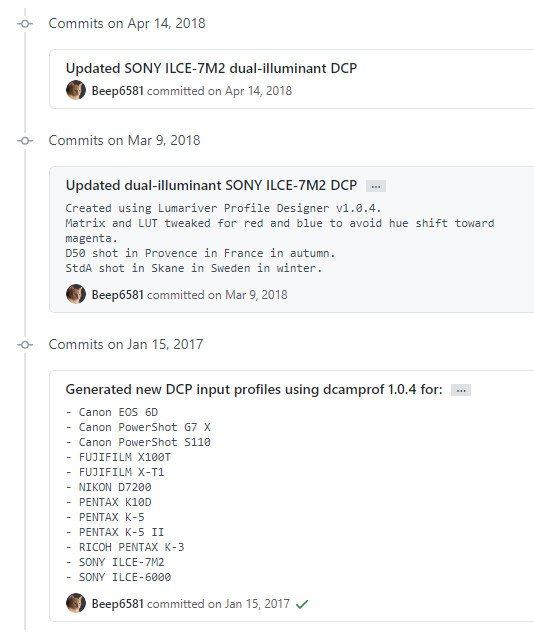RT ships a dcp file for D700 which was made by @Morgan_Hardwood, me and a bottle of wine using my D700. Maybe that’s the cause the D700 colours look better ![]()
Maybe there is some discoloration in the shadows because the high iso.
My edit without touching white balance
S7_07667.ARW.pp3 (13.5 KB)
it very well may be why 
You know, RawTherapee actually ships with a custom DCP for the a7ii.

@Morgan_Hardwood, the commit on March 9 is well documented, but do you remember what changed for the commit on April 14? It’s two years ago though…
So if I understand well the RawTherapee team put together a custom profile for this camera in order to avoid the magenta shift …which means the magenta shift was even worse then than now  ? wow
? wow
That or perhaps my version of RT doesn’t use it? Any way to check?
I am using RawTherapee AppImage 5.8-2437-gea485e4
The way to check is to toggle between ‘Camera standard’ (which uses the dcraw matrix) and ‘Auto-matched camera profile’ (which uses the DCP). It will also enable the options in the DCP block. Only have ‘Base table’ checked (but YMMV with Tone curve and Look table as well).
Edit: the profile is in RT for two years already, yours should support it.
i guess it uses it; there is a slight change in lightness but nothing radical in colour.
Wouldn’t it be more correct to use Custom instead of Auto-matched to check this? This would exclude the possibility, that, for whatever reason (bug) RT picks the wrong dcp accidentially.
Here’s the rawproc screenshot, with the metadata-suppled black subtract, libraw-supplied dcraw primaries, and a filmic curve (in the parameters pane):
The magenta cast is about not doing the black subtract, or doing it with an incorrect number; that is just part of the raw processing to compensate for dark current in the sensor that keeps black from being 0.
The dcraw primaries yield an acceptable (well, to me, anyway…  ) color rendition.
) color rendition.
It takes a steep filmic curve to pull the image out of the shadows , although it’s worth noting that the bits of sky in the top-right are blown.
So, I don’t think there’s anything extraordinary to regular camera default processing needed for this image. S’why I like rawproc; all that is done to the image from the very start is displayed in unambiguous and explicit order in the tool chain… however, do not download it, it’s too hard to use. 
In my very quick edit, the greens appear heavily saturated because I probably didn’t push the exposure enough, and the tone curve is causing the underexposed image to appear heavily saturated (local contrast probably adds in a bit of saturation too) Here is the same image I edited before, but pushing the exposure compensation up to +4EV.
Just as a point of comparison, here is the image pushed to the same exposure, with the camera-suggested white balance:
Just FYI, here is “what the sensor sees”, taking the raw tristimulus values and dropping them straight into an sRGB colorspace, no white balance or tone curve, just demosaicing and scaling:
So a raw editor is always going to be applying some sort of “editing”, at a minimum to map the sensor values in a sensible way into a standard colour space, adjust the balance between the channels, and apply some sort of tone mapping. Particularly the tone mapping will affect the look of the image, and different editors take different approaches here. In darktable, I used filmic for tone mapping, but I could have used base curve for a different result, and RT even uses some sort of histogram equalistion process to make the raw image look more like the OOC JPEG that the manufacturer creatively processes inside the camera. So, Raws are maybe not quite as objective as one might first suppose.
I’m sorry I guess I was being a bit overly dramatic there 
Thanks for the feedback though!  much appreciated!
much appreciated!
@heckflosse do you guys use an open source program to modify the dcps? Would I be able to modify the one that is there for the Sony a7ii and make one with more tame greens ?
…or, perhaps, can I dare request one being added?
You need dcamprof:
https://torger.se/anders/dcamprof.html
Anders Torger was (is?) a RT developer, and he also wrote this wonderful piece of command-line software to do anything you can imagine to a DCP. And his extensive documentation will tell you anything you need to know about the program and the environs surrounding DCP, and a good bit of ICC.
With it, you can take any DCP, translate it to JSON, edit to your heart’s content, and re-generate the modified DCP. And in doing this, you’ll learn more about color management than you ever believed you could…




